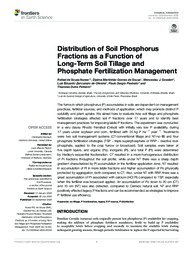Distribution of Soil Phosphorus Fractions as a Function of Long-Term Soil Tillage and Phosphate Fertilization Management.
Distribution of Soil Phosphorus Fractions as a Function of Long-Term Soil Tillage and Phosphate Fertilization Management.
Autoria: NUNES, R. de S.; SOUSA, D. M. G. de; GOEDERT, J. W.; OLIVEIRA, L. E. Z.; PAVINATO, P. S.; PINHEIRO, T. D.
Resumo: The forms in which phosphorus (P) accumulates in soils are dependent on management practices, fertilizer sources, and methods of application, which may promote distinct P solubility and plant uptake. We aimed here to evaluate how soil tillage and phosphate fertilization strategies affected soil P fractions over 17 years and to identify best management practices for improving labile P fractions. The experiment was conducted in a very clayey Rhodic Ferralsol (Oxisol) with initially very low P availability, during 17 years under soybean and corn, fertilized with 35 kg P ha?1 year?1 . Treatments were two soil management systems (CT-conventional tillage and NT-no-till) and four phosphate fertilization strategies (TSP ? triple superphosphate or RRP ? reactive rock phosphate, applied to the crop furrow or broadcast). Soil samples were taken at five depth layers, and organic (Po), inorganic (Pi), and total P (Pt) were determined by Hedley?s sequential fractionation. CT resulted in a more homogeneous distribution of Pi fractions throughout the soil profile, while under NT there was a steep depth gradient characterized by Pi accumulation in the fertilizer application zone. NT resulted in accumulation of Pi in more labile fractions and higher accumulation of Po physically protected by aggregation, both compared to CT. Also, under NT with RRP, there was a great accumulation of Pi associated with calcium (HCl Pi) compared to TSP, especially when the fertilizer was broadcast applied. An accumulation of Po down to 20 cm (CT) and 10 cm (NT) was also detected, compared to Cerrado natural soil. NT and RRP positively affected legacy P fractions and can be recommended as strategies to improve P fertilizer use efficiency. Keywords: no-tillage, P fractionation, legacy P, P source, P distribution
Ano de publicação: 2020
Tipo de publicação: Artigo de periódico
Unidade: Embrapa Cerrados
Palavras-chave: Fixação de Fósforo, Fósforo, Plantio Direto
Observações
1 - Por padrão são exibidas publicações dos últimos 20 anos. Para encontrar publicações mais antigas, configure o filtro ano de publicação, colocando o ano a partir do qual você deseja encontrar publicações. O filtro está na coluna da esquerda na busca acima.
2 - Para ler algumas publicações da Embrapa (apenas as que estão em formato ePub), é necessário ter, no celular ou computador, um desses softwares gratuitos. Sistemas Android: Google Play Livros; IOS: iBooks; Windows e Linux: software Calibre.
Acesse outras publicações
Acesse a Base de Dados da Pesquisa Agropecuária (BDPA) para consultar o acervo completo das bibliotecas da Embrapa.

